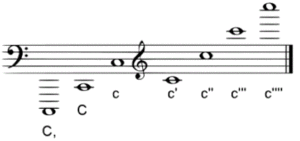There are eight different categories for the soprano voice in the Fach system separated into two main divisions, the Spiel- and Charakterfächer and the Seriöserfächer. Follow the links to both sound examples and an extensive listing of typical roles and audition arias.
Part two: Seriöser Fächer [ze.ʁi.’ø:.zɐ ‘fɛ:.çɐ]
Lyrischer (Hoher) Sopran [‘ly:.ʁɪ.ʃɐ ‘ho:.ɐ so.’pʁa:n] (c’-c”‘):
- A supple voice with a beautiful mellow quality and a noble line.
Lyrischer (lyric) here does not mean light but rather the ability to sustain lines with more voice and full legato line than the singers of the spiel Fach. The important roles in this Fach are Pamina in Die Zauberflöte, Mimi in La bohème, Rosalinda in Die Fledermaus, and Michaela in Carmen. Regarding appearance, the Lyrischersopran must have a somewhat softer, more sympathetic personality than the Soubrette; she should be attractive, appealing, and very feminine on stage. Although it is unlikely for the mature Lyrischersopran to move into a heavier Fach (the voice lacks the metallic ring) a young singer of the Jugendlicher-dramatischersopran Fach often will sing some of the roles of the Lyrischersopran repertoire.
Example: Elizabeth Schwarzkopf in Le nozze di Figaro.
Lyrischer (Hoher) Sopran roles and arias
Dramatischer Koloratursopran [dʁa.’ma:.tɪ.ʃɐ ko.lo.ʁa.’tu:ɐ̯.zo.’pʁa:n] (c’-f”):
- A flexible voice with an extended upper range and capable of dramatic outbursts.
This is a very special Fach and one which is not easily understood by Americans. The ability to sing coloratura passages is important, as it is with the Koloratursoubrette, but the voice must have the beautiful line of the Lyrischersopran as well as being capable of dramatic outbursts. Typical roles include Fiordiligi in Così fan tutte, Violetta in La Traviata and Kostanza in Die Entführung aus dem Serail. The role of the Königin der Nacht in Die Zauberflöte is a specialty role and is not necessarily sung by all singers of this Fach. This voice is also usually asked to sing the Italian roles which include heavier music for the coloratura voice. The type of character portrayed is often a loftier figure than that presented by the Lyrischersopran or the Soubrette. It is possible for a singer of the Dramatischerkoloratursopran Fach to move into the true Lyrischersopran Fach later in her career if her vocal and physical size permit it.
Singers: Christina Deutekom, Joan Sutherland, June Anderson, Ruth Ann Swenson, Edita Gruberova, and Mariella Devia. Maria Callas and Montserrat Caballe also sang this Fach during their careers.
Example: Christina Deutekom in Die Zauberflöte.
Dramatischer Koloratursopran roles and arias
Jugendlich-dramatischer Sopran [‘ju:.gənt.lɪ.çɐ dʁa.’ma:.tɪ.ʃɐ so.’pʁa:n] (c’-c”‘):
- A voice with a good line, power and a good deal of metal; capable of moments of dramatic outbursts.
This is the Fach which is most important for the German repertoire, yet we do not even have an equivalent English name which is in common usage. It is best thought of as a heavy spinto soprano. The most important German roles include Agathe in Der Freischütz, Elizabeth in Tannhäuser, and Elsa in Lohengrin. The appearance of this person must be beautiful on stage, although, with a few exceptions, the roles for this voice are somewhat static, and do not require the acting ability of the Soubrette. They do, however, require great emotional intensity, and the ability to sing long vocal lines in heavy ensembles without becoming tired or strained. This is truly a young-dramatic voice that often moves into the dramatic Fach later in her career.
Singers: Leontine Price, Gwyneth Jones, Callas, Caballe, Tebaldi, Zinka Milanov, Leontyne Price, Aprile Millo, Susan Dunn, Deborah Voigt, Alessandra Marc, and Sharon Sweet. Cheryl Studer, and Carol Vaness sing roles in the lyric, spinto and coloratura repertories.
Example: Zinka Milanov in Il trovatore.
Jugendlich-dramatischer Sopran roles and arias
Dramatischer Sopran [dʁa.’ma:.tɪ.ʃɐ zo.’pʁa:n] (b-c'”):
- A large, metallic voice with great dramatic penetrating power.
The dramatic soprano in the German-speaking opera houses has the responsibility of performing the big Verdi roles, such as Aïda, Amelia in Un ballo in maschera, and Leonora in La forza del destino. She also sings the title roles in Ariadne auf Naxos, Tosca, and Fidelio. Singing ability takes precedence over visual effectiveness in this Fach, but she should be a person capable of great emotional depth. Her vocal quality is dominated by an intense metallic ring and great volume.
Singers: Eva Marton, Birgit Nilsson, Hildegard Behrens, Eva Marton
Example: Sena Jurinac in Don Carlo.
Dramatischer Sopran roles and arias
Hochdramatischer Sopran [‘ho:x.dʁa.’ma:.tɪ.ʃɐ zo.’pʁa:n] (g-c”‘):
- Large, heavy and projecting voice with a well-developed middle and low registers.
We generally include much of the repertoire of the dramatic soprano when we think of this Fach. However, in the German theater system, it is reserved for only the extremely taxing roles, such as Isolde, Brünnhilde, and Elektra. This woman should be big vocally and physically. The ability to sustain extremely long vocal lines over a full orchestra is the first prerequisite. This is a Fach only arrived at after years of professional singing.
Singers: Birgit Nilsson, Dame Eva Turner, Eve Marton, Ghena Dimitrova, Gwyneth Jones, Linda Kelm, Kirsten Flagstad
Example: Birgit Nilsson in Götterdämmerung.
Hochdramatischer Sopran roles and arias
______________________________________
Helmholz notation:

(This article is the fourth part in the series on the German Fach System and is based on information derived from Rudolf Kloiber’s “Handbuch der Oper”, 9th edition, Deutschen Taschenbuch Verlag. Read the first part of this series here.)
